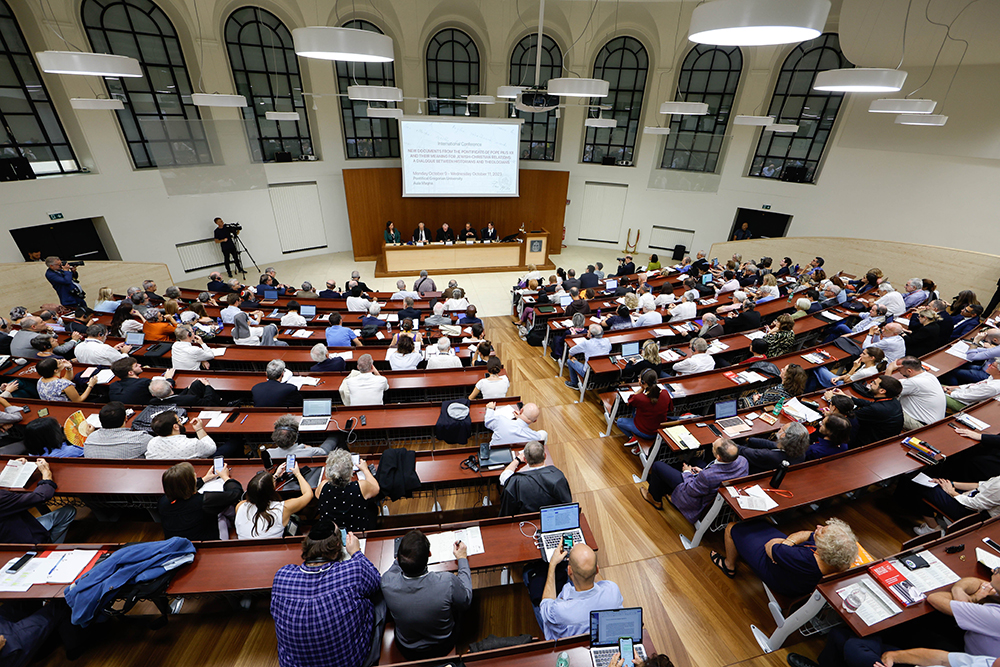
By Carol Glatz
ROME (CNS) — Generosity and compassion for those fleeing persecution prevailed over racial laws and centuries-old anti-Semitic prejudices in Nazi-occupied Italy, some Jewish and Catholic historians said at an international conference.
Before anti-Semitism was declared a sin with the Second Vatican Council, it was commonplace for Catholics “to think of Jews and Judaism as something dangerous, something different,” said Suzanne Brown-Fleming, director of international academic programs at the U.S. Holocaust Memorial Museum, opening the conference Oct. 9.
However, many Catholics overcame these prejudices to rescue and save Jewish people in danger, “sometimes at the cost of their lives. Others did not. And that’s fascinating … somehow, those who were able to break out of this thinking brought us to the Second Vatican Council,” she said.
Brown-Fleming was one of dozens of scholars speaking at an Oct. 9-11 conference at Rome’s Pontifical Gregorian University focused on recent research into the Vatican archives of Pope Pius XII’s pontificate before, during and after World War II.
Liliana Picciotto, a Holocaust historian at the Jewish Contemporary Documentation Center Foundation in Milan, said Oct. 10, “There were 38,994 Jews in Italy on the eve of the German occupation,” Sept. 8, 1943. Some 81% of them were saved, she said; unfortunately for more than 7,000 Jews across Italy, “there was nothing to be done,” and they were arrested and deported to extermination camps.
After years of war and now with the Italian Fascist state becoming a Nazi-German puppet state, there were also tens of thousands of others needing help: escaped Allied prisoners of war, Italian civilians and young Italian soldiers who all risked being labeled enemies of the state and deportation by German authorities, she said. In addition to waves of destitute citizens flooding the capital from the south, Rome’s population went from about 850,000 to 1,500,000 people in this short period of time and they all needed clothing, food and protection.
Many laypeople and the Catholic Church “abundantly distributed assistance to all of them and without distinction,” she said, “including taking in Jews,” who had already been unjustly discriminated against by Italian racial laws since 1938, but now faced mass arrests and deportations after the German invasion.
Neighbors, hospitals, parishes, religious houses, seminaries, papal institutes and other church-owned structures opened their doors while some laypeople and clergy ran organized clandestine networks that helped smuggle thousands of Jews into Switzerland, procure false documents or hide them in their communities.
“Thousands of people were helping thousands of other people,” in a kind of underground popular movement after decades of dictatorship, said Picciotto.
Rome had the largest Jewish community of 12,000 people and “the largest concentration of religious houses in Italy,” she said. Many of Rome’s Jews, especially after the Nazi raid on Rome Oct. 16, 1943, “were saved thanks to the hand extended to them by church structures.” Some 1,259 people, mainly members of the Jewish community, had been taken by the Nazis that day.
A total of 27,500 Jews were rescued in all of German-occupied Italy, she said, and “between a quarter and a fifth of them were saved thanks to the outreach of the church,” she said.
Picciotto said a number of documents she found suggest initiatives were taken by the “middle tier” of the church hierarchy, where leaders let their superiors know they were aiding the persecuted, but without waiting for their permission and “without getting them involved.”
Sister Grazia Loparco, a Salesian sister of St. John Bosco, who spoke at the conference Oct. 10 told Catholic News Service Oct. 9 that religious superiors decided individually what their house would do, with many helping, and some not.
Cloistered convents and monasteries, however, did need permission from their bishop or his representative to let in outsiders, she said. For Rome, this would be the pope’s representative, called an apostolic visitor, who documented there had been 99 Jews hidden in 11 cloistered convents. Picciotto said the visitor, identified only as Father Giovanni, directly found shelter for 176 people — civilian fighters and Jews — in the monasteries and convents he oversaw.
Sister Loparco, a professor of church history at Rome’s Pontifical Faculty of Educational Sciences “Auxilium,” said it is highly unlikely Pope Pius XII directly wrote an order to hide Jews and others because a written directive would have been too risky. “However that he was aware and that he supported this is very clear” since the cloistered monasteries had been given permission to do so.
She told the conference that oral communication in the church hierarchy “worked very well in Rome.” Every morning a priest from the Vatican or the Diocese of Rome visited each women’s religious house in order to celebrate Mass, making it “very easy” to pass along information.
Sister Loparco’s own research together with new documents found in the archives of the Jesuit-run Pontifical Biblical Institute in Rome have found at least 100 women’s and 55 men’s religious congregations offered hospitality to 4,300 people in Rome.
She said that since the new research came out in September, she was still getting information from people finding diaries or evidence in their archives of clandestine rescues in religious houses.
The delay and surprises in learning about the past, she told CNS, is often because there is no trained archivist to access the materials or the archives have not been catalogued.
Also, she said, religious women and men saw helping the Jews and others was none other than their basic duty to offer charity and save innocent human lives, no matter the risk.
But the occupation of Rome took their mandate to love and protect to a new level, she said, as the religious and those they cared for lived under the same roof and “shared the fear, shared the risk, they shared everything there was, so they created a closeness that was not doctrinal but was human.”
